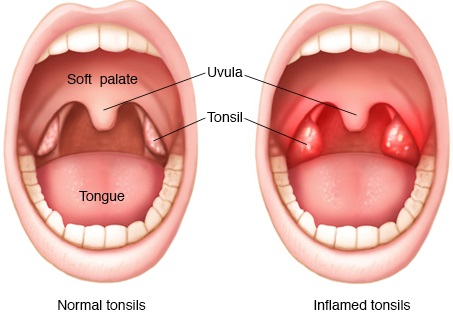Tonsillectomy refers to a medical procedure in which tonsils are removed. Tonsils have white blood cells that help your body fight infections. Tonsillitis is the infection of the tonsils, which gives you a sore throat and cause tonsils to swell. Tonsillectomy is a remedy for frequent tonsillitis. The surgical procedure can also treat breathing problems such as sleep apnea and heavy snoring. You should take good care of yourself after this procedure. But how long does tonsillectomy recovery take? This article addresses this question and outlines ways of speeding up the recovery process.
Tonsillectomy Recovery Time
The tonsillectomy recovery time varies depending on patients' age. The table below outlines the recovery time for different age groups.
|
Age Group |
Recovery Time |
|
2-5 Years Old |
|
|
5-12 Years Old |
|
|
12-19 Years Old |
|
|
Over 19 Years Old |
|
How to Speed Up Your Tonsillectomy Recovery Process
This section outlines various ways in which you can speed up the tonsillectomy recovery process.

1. Right After Surgery
- A tonsillectomy patient is taken to the recovery room after the surgery. A nurse monitors his or her progress here.
- Relatives are encouraged to stay with the patient in the recovery room. This helps patients familiarize with their surroundings especially children who need their parents around.
- A patient can go home on the same day after recovering from anesthetic, which takes several hours. The patient will need someone to pick him or her from the hospital and spend the first night with the patient.
2. Home Care
The patient should go straight to bed after arriving home from hospital. The patient should rest with 2 or 3 pillows to elevate his or her head above the heart to reduce the risk of swelling and edema. Placing a cold or ice press on neck will reduce the swelling.
The patient may need assistance when using the bathroom. It is advisable to minimize visitors because they may over excite or introduce new infections to the patient. In case of constipation, the patient should take a gentle laxative or stool softener.
3. Diet
- The patient may feel hungry after surgery, but it is advisable to introduce foods slowly to prevent vomiting and postoperative nausea. Patient may vomit once or twice after surgery. The doctor will prescribe medications if vomiting is persistent.
- It is normal for patients to lose weight after tonsillectomy. During the recovery process, patients should not be worried about their diet as long as they take enough fluids which can help in preventing dehydration and bleeding. The recommended drinks include thin, dilute frozen popsicles and non-acidic drinks.
- Recovering patients can also eat cool, soft and light foods such as mashed foods, ice cream, puddings, gelatin, and custards. They should avoid coarse, hot, spicy and scratchy foods such as potato chips, fresh fruits, crackers and toast. Uncontrollable dehydration may require hospitalization for the patient to receive intravenous fluids.
4. Medication
The doctor may prescribe antibiotics after surgery, which should be taken as prescribed. Doctor may also prescribe a narcotic like acetaminophen or Tylenol with codeine. The patient should not drive under narcotics. Anti-emesis medications such as ondansetron or Zofran and promethazine or Phenergan may be prescribed if the patient suffers from vomiting or nausea. Caregivers can consult a doctor if the patient reacts to the prescription. Patients should avoid any OTC or prescription medications before they get doctor's approval.
5. Pain Management
Pain during tonsillectomy recovery process is common. It is difficult to predict if patients will have prolonged pain or will recover quickly. Patients may experience minimal pain immediately after surgery, but the pain may increase the following day and persist for several days. Painful sensation may recur after a week in the ears when patient swallows. At this time, the scabs may fall off and bleeding may occur. Then patients may experience reduced pain and recover fully within two weeks after tonsillectomy. However, the patient's throat will remain sensitive to spicy and hot foods for about 6 weeks.
6. Bleeding Care
1% to 3% of patients suffer bleeding 5-10 days after surgery. Excessive activity and dehydration increase the risk of bleeding. The patient should remain relaxed and calm when bleeding. He or she should rinse the mouth with cold water and continue to rest with an elevated head. See a doctor if bleeding persists. The treatment is simple but in some rare cases, patients have to undergo surgery to cauterize the bleeding area. A blood transfusion is necessary in some rare cases.
7. Other Management Tips
Tonsillectomy leaves white patches or scabs at the back of the patient's throat where tonsils were located. These scabs are not signs of an infection. There is no need to remove the patches because they fall off within two weeks after surgery. They may cause bad breath but the smell will disappear when the area heals.
The throat will turn back to pink in 6 weeks while the nasal stuffiness will disappear after several month when the swelling resolves. The patient can use saline nose drops to reduce edema and eliminate clots. Other changes that the patient should expect include persistent and louder snoring for some weeks and a voice change for several months
When to See a Doctor
During tonsillectomy recovery process, you should call the doctor if the patient:
- Has increased bleeding through nose or mouth that takes a long time to stop;
- Suffers from a persistent fever above 38.6°C or 101.5 °F, which forces the patient to take more fluids and acetaminophen;
- Experiences a headache or sharp pain that persists after taking pain relievers;
- Has increased redness or swelling of the neck, nose and eyes.
